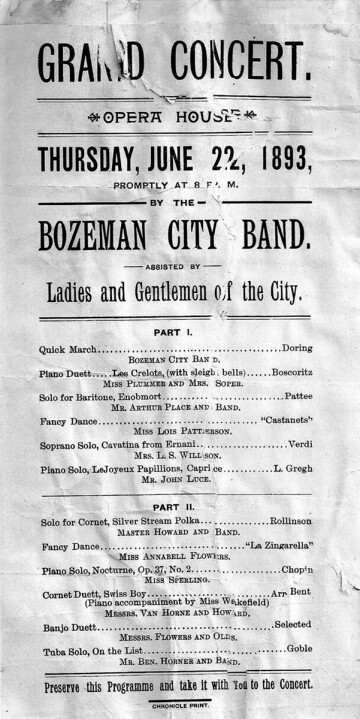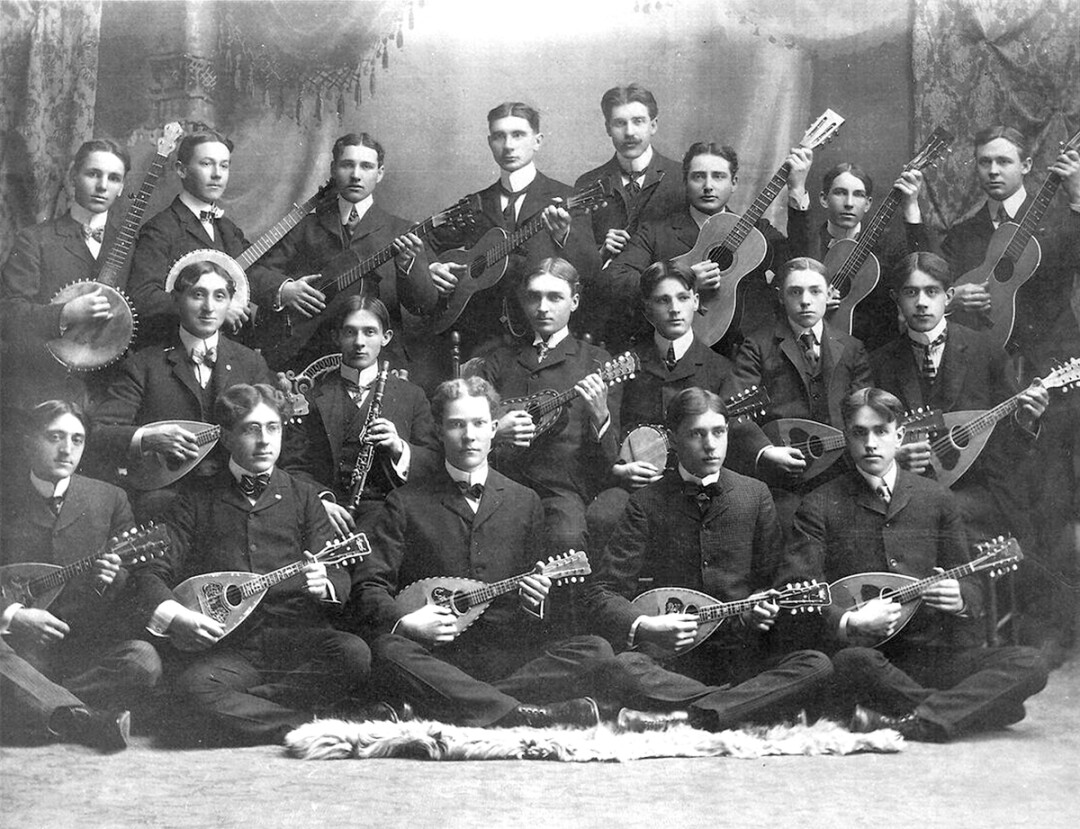Bozemans Early Music Scene...and The Bands Played On
Cindy Shearer | Friday Sep. 1st, 2017
From day one, music has been played in Bozeman. Local kids and ladies and cornet players entertained Bozeman residents in the city’s early years, and as Bozeman was changing from a frontier town to a civilized city, local music changed as well.
In 1880, nine years prior to Montana’s statehood, The Bozeman Silver Cornet Band, led by A.B. Charpie, was entertaining area residents and performing for official city events. This first city band was reorganized by Charpie and became the Queen City Band, and their first official performance was to celebrate the arrival of the Northern Pacific Railroad to Bozeman in 1883.
The Queen City Band marched in the July 4, 1888 parade that Bozeman Mayor John Bogert had orchestrated to provide the backdrop for the ceremonial laying of the cornerstone of the new Bozeman Municipal Building that would be the home of the city business office, police, and fire departments, as well as the beloved Bozeman Opera House.

Upon completion of the Bozeman Opera House, the Queen City Band presented the first program, a benefit on September 19, 1890 to raise money for the curtains and scenery. The dedication, scheduled for that evening was postponed because of the uncertainty of being able to light the building electrically as the water needed to supply the generator was low.
The Bozeman Kid band later named the Bozeman Free Silver Kid Band was organized in 1892 under the direction of Lou Howard and is thought to be the first kid band in the state. The band members comprised 13-15 boys and included five Howard brothers, Byron and Walter Story, Fred F. Willson, and Reno Sales. The band members wore brass-buttoned uniforms cut to size by their mothers. This band functioned for several years including playing on Main Street Christmas day 1893. The Avant Courier newspaper wrote, “was a pleasant day and the streets were dusty.” They also provided music for the ceremonies when the cornerstone for Montana Hall at Montana State College was laid in October 1896.
The Bozeman Brass Band succeeded the Kid band about 1908, with the addition of some older musicians and Lou Howard still leading. Five years later, the Bozeman Chamber of Commerce Band was formed. Many members of the 1913 band went overseas during World War I and, upon their return, most of the men joined the 163rd Infantry, Montana National Guard Band, with Warrant Officer John Fechter as the director.
Referred to as the 163rd Regimental Band, this band performed concerts at Beall Park in the summer months and moved inside to the Municipal Theater/Bozeman Opera House for winter performances. Concert organizers were unsure how the community would attend an inside performance of the band and were astounded with standing room only crowds.
In 1921, the band became the Bozeman Municipal Band and in 1940, the members of the band who were physically qualified again went to war, and in the interim, a city band was formed by two of the band veterans, Lou Howard and Bud Henke. Howard resigned as leader in 1945 and Paul Enevoldsen became the director. The baton would later be passed to Edmond Sedivy, Francis White, and Rolf Johnson. The Bozeman Municipal Band still plays every summer at Bogert Park on Tuesday evenings.
In February of 1902, Bozeman was a wild frontier town with a passion for the arts. On February 14, world-renowned mandolin virtuoso, Samuel Siegel performed at the Bozeman Opera House. He inspired the entire audience and sparked enough interest that the Bozeman Mandolin and Guitar Club was born.
The instrument was affordable to the working-class immigrants and would be easily purchased from the Sears catalogue. From about 1890 to 1925, companies such as Gibson and Martin employed salesmen who traveled across the United States selling instruments in the mandolin family. The salesmen quickly found that they could generate more sales by establishing mandolin orchestras in the towns they visited. Playing in the local mandolin orchestra became “all the rage” for the men and women of polite society. Mandolin clubs, societies and orchestras soon became plentiful across the nation with Bozeman being no exception. Mandolin groups played arrangements of light classics, overtures, dance music, and some original works for mandolins. The players read regular musical notation, and a high standard of technique was developed.
The early members of the Bozeman Mandolin and Guitar Club would never know that they would later be the inspiration for the formation of the 1999 Montana Mandolin Society.
At the turn of the century, Bozeman women were active in community clubs, arts, education and cultural organizations, and in 1906 The Ladies Imperial Band was formed under the direction of Mr. and Mrs. Jesse Thompson. In photographs of the band, they wore several different uniforms including military styled dress uniforms, corduroy suits for special occasions and sometimes performed in all white dresses and hats. The Ladies Imperial Band soon became a town favorite and marched in the 1906 and 1907 Sweet Pea Carnival parades. While it was not common for town women to be in saloons in this era, the Ladies Imperial Band did perform in many local saloons much to the cheers of the patrons.
The musical taste of Bozeman was changing as the town was transitioning from being a frontier town to a civilized city and classical music became more and more frequently performed. Residents were being well entertained by numerous orchestras in the schools and churches, and after the Opera House was built, many traveling productions exposed area citizens to even more refined musical experiences.
When John Fechter settled in Bozeman as the new manager of the Tivoli, he had just completed a tour as an oboe player with John Phillip Sousa’s Band. He directed a local band known as the German Band which played at community picnics, and in 1910 conducted the first concert of the Bozeman Symphony in the Gem Theater located at 126 West Main.
The orchestra’s membership consisted of some well-known Bozeman names, T. Byron Story, W.S. Boles (the town doctor who played bassoon), Fred F. Willson (a leading Montana architect and cellist), and Theo Stumpf (a viola player who also owned a saloon). Pianist, Zeda Sales Dixon was said to have kept hot potatoes in her coat pockets to keep her hands warm before a performance.
There was always overlap between the Montana State College music department and the local non-student musicians of Bozeman, and at times it is difficult to determine if there was one Bozeman Symphony or two, one being mostly comprised of faculty and students and the other mostly non-student residents. It is very clear though that the demand for live classical music was well supported in Bozeman.

In 1919, Bozeman Symphony was under the direction of Gifford Nash. An Englishman, Nash was at that time the head of the Montana State College music department which boasted a three-member faculty. That year a concert was held at the Municipal/Bozeman Opera House and featured a Mendelssohn piano concerto by Miss Myrtle Hollier (later she married Bert Cheever). The 33-member orchestra’s music “wasn’t just pickin’s,” according to Mrs. Cheever; it played the great classics by Grieg, Dvorak, Tchaikovsky and more.
In 1925, the Ellen installed a $16,000 Wurlitzer organ which, on opening night, featured organist Adolph Evans, Jr., and Fechter’s Bozeman Symphony playing Rossini’s overture to Will Tell. Evans also played the popular hit “Follow the Swallow” as the audience sang along, reading words flashed on the screen.
In a 1934 program from the Bozeman Woman’s Club Annual Musicale, the Bozeman Union Symphony Orchestra gave a performance at the Hotel Baxter. The program lists 21 members with the Director as John G. Fechter, the Manager as Louis True, and the Pianist as Mrs Hadleigh Marsh.
In a New York Times article by Bruce Weber in 1999 he wrote of the survivalist mentality for artists. “Unlikely as it sounds, in a place where ranching and outdoor tourism are the primary economic forces, Bozeman offers a good example of the survivalist mentality that one finds among artists in cities throughout the country, where, like desert flowers, the arts manage to bloom without the presumed-to-be-necessary life sustaining elements of a national spotlight and available money.”
Bozeman City Founders would be pleased to know that the cultural foundation that was important to them is still an integral aspect of current living in this place we call home, Bozeman Montana.
| Tweet |
